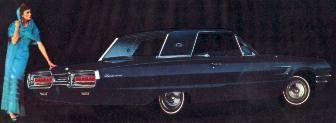| Specifications 1965 THUNDERBIRD |
|
 Hardtop above shown in Caspian Blue Metallic paint (code H). |
|
|
ENGINE CODES 9 - 390 Cubic Inch V-8 (Researching Horsepower) (Export only; low octane) 4-Barrel Ford Carburetor/Dual Exhaust System Z - Thunderbird 390 Special V-8 (300 Horsepower) 4-Barrel Ford Carburetor/Dual Exhaust System |
|
|
TRANSMISSION CODES 4 - Cruise-O-Matic (Automatic, 3-Speed—Cast Iron) 6 - Cruise-O-Matic (Automatic, 3-Speed) |
|
|
REAR AXLE CODES 1 - 3.00:1 4 - 3.25:1 5 - 3.50:1 6 - 2.80:1 A - 3.00:1 Equa Lock D - 3.25:1 Equa Lock E - 3.50:1 F - 2.80:1 |
|
|
WHEELBASE 113.2 Inches Length: 205.4 Inches (Overall) Width: 77.1 Inches Height: Hardtop - 52.5 Inches; Landau - 52.7 Inches; Convertible - 53.3 Inches Weight: Hardtop - 4,470 Pounds; Landau - 4,478 Pounds; Convertible - 4,588 Pounds |
TIRES Original Manufacturer: Firestone, Goodyear Size: 8.15 x 15 Optional Whitewall: 1 Inch (Early); 3/4 Inch (Late); Optional Red Band: 3/4 Inch White Stripe with 3/8 Inch Outer Red Band with 3/8 Inch Separation Between White and Red Bands |

That was one thing that could never be said about the 1955-1964 Thunderbirds.
Criticized for years about their brakes, which were prone to overheating
and fade, you could say that this was the T-Bird's Achilles heel. A weak
spot that couldn't be covered up with new sheet metal and spiffy wheel
covers. To be fair, this was a problem with most—if not all—cars
made during this time. The Thunderbird seemed worse than some, due probably
to the weight of the car.
But from 1965 on, the Thunderbird became lauded for its braking prowess. Other luxury car makes (with the exception of Lincoln) were somewhat slow to respond to this significant safety improvement. Cadillac offered disc brakes as an option on its new Eldorado in 1967, after a November 1966 road test by Car and Driver Magazine reported the brakes on the Eldo as "treacherous and unsafe." It further went on to say the Eldorado "managed to smoke and slew to a halt—sideways in the road—in a pitiful 386 feet." This comparison included the 1967 Thunderbird, on which Car and Driver commented: "...the car maintained acceptable directional stability under heavy braking and came to a halt within reasonable limits." The new dual-piston disc brake for 1965 was vastly superior to the drum brake in every area. Discs are less prone to pulling and fade, require less attention, and their inclusion on the Thunderbird has resulted in some very unique considerations, which affect owners to this day. One of the biggest is that the 15 inch wheels, which were introduced in 1964 on all T-Birds not equipped with the Wire Wheel option, are not interchangeable. The steel wheels themselves are different, in order to accommodate the front disc brakes.This has led a few owners to discover that they can't move their car after installing a pre-1965 wheel on the front. These wheels normally work fine on the rear, since the rear axle is equipped with drum brakes, and don't require the additional clearance. We've heard more than one owner tell the story of the time he had to change a flat tire, and couldn't figure out why the wheel wouldn't work properly. Just another example of why there is still much to learn about these cars, and why Thunderbird is still unique in all the world! |
|